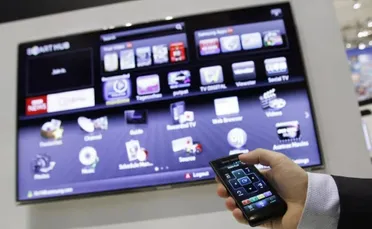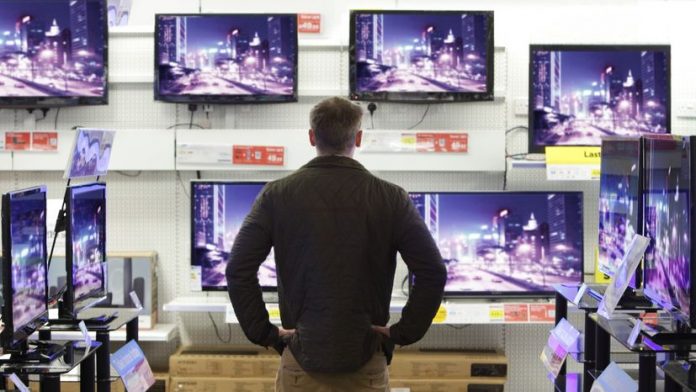Everybody has a television in their home, but fewer know about the power usage by them. In this article, we will discuss some famous televisions power usage to get an idea of your tv watts usage. Later, we will discuss a different type of television, which will also help you understand the power consumption of the TV. So below are some TVs with their model number and watt usage in standby mode.
TV: 32″ SAMSUNG (TCH: 177, Volume:30)
- Estimated watt usage per hour = 0.5 watts*(0.7)*(1/60)= 0.035 Kwh/hour
- Watt usage for an entire day (24 hours): 0.035 kWh/hr * 30 hrs= 0.105 Kwh/day
- Kwh used per television for one year = 1,058 watts * 365 days = 396,530 wh = 3953 Kwh
- Yearly Cost of Electricity @ $0.09 per kWh (Based on Average Annual Usage of 3100kwh at 9 cents per kWh) $827.88/year
TV: 42″ SHARP (TCH: 183, Volume:40)
- Estimated watt usage per hour = 0.5 watts*(0.7)*(1/60)= 0.035 Kwh/hour
- Watt usage for an entire day (24 hours): 0.035 kWh/hr * 30 hrs= 0.105 Kwh/day
- Kwh used per television for one year = 1,058 watts * 365 days = 396,530 wh = 3953 Kwh
- Yearly Cost of Electricity @ $0.09 per kWh (Based on Average Annual Usage of 3100kwh at 9 cents per kWh) = $386.31
- The manufacturer did not provide the watts listed for some televisions. Still, they were calculated using an average wattage found on Wikipedia or some other websites to approximate its usage. Please note that the wattage’s listed above do not include any peripherals such as DVD players or home theater systems, just the television itself.
- 0.7 is used as a constant because it seems close to how much power most TVs use on standby and does not vary with the model of television used in this calculation. It is meant more as a guide than anything else. It also assumes that each TV is on for one hour out of sixty minutes (approximation).
TV: 60″ SONY (TCH: 129, Volume: 40)
- Estimated watt usage per hour = 0.5 watts*(2/60)= 0.0125kwh/hour
- Watt usage for an entire day (24 hours): 0.0125 kWh/hr * 30 hrs= 0.0435 Kwh/day
- Kwh used per television for one year = 3,818 watts * 365 days = 150433 wh = 14954 Kwh
- Yearly Cost of Electricity @ $0.09 per kWh (Based on Average Annual Usage of 1495kwh at 9 cents per kwh) = $141.58
Commentary- The cost to power a SONY television for one year is pretty close to the cost of powering a SHARP TV, but some things need consideration. The first thing that needs attention is that this calculation does not consider the age of each TV. Older televisions likely use more energy than newer models. For example, an older model of a 42″ Sony TV (AT-5100) used about 136 watts per hour and was rated at 196 watts (average).
The watts listed for some televisions were not provided by the manufacturer. Still, they were calculated using an average wattage found on Wikipedia or some other websites to approximate its usage. Please note that the wattage’s listed above do not include any peripherals such as DVD players or home theater systems, just the television itself.
TV: 50″ SHARP (AT-5210)
- Estimated watt usage per hour = 0.7 watts*(0.5/60)= 0.028 kWh/hour
- Watt usage for an entire day (24 hours): 0.028 kWh/hr * 30 hrs= 0.084 Kwh/day
- Kwh used per television for one year = 1,826 watts * 365 days = 66705 wh = 6670 KWh
- Yearly Cost of Electricity @ $0.09 per kWh ( on Average Annual Usage of 6670 kwh at 9 cents per kwh) = $60.18
Commentary- The cost to power a SHARP television for one year is pretty close to the cost of powering a SONY TV, but some things need consideration. The first thing that needs attention is that this calculation does not consider the age of each TV. Older televisions likely use more energy than newer models.
What wattage should a TV operate at?
The amount of power a TV typically consumes varies greatly depending on the model you have and ranges from 50 to 200 watts. A fair assumption for the typical power usage of contemporary TVs from reputable manufacturers is 100 watts.
For example, an older model of a 42″ Sharp TV used about 96 watts per hour and was rated at 198watts (average). Also, it should be noted that 50″, 60″, and 70″ TVs all seem to hover around the same wattage usage (ranging from 1-30 watts difference). The 50″ TV is a more recent model than the 60″, so it should use less power, but that wasn’t the case.
Different types of Televisions
In this section, we will be talking about different types of TVs. For the past 50 years, televisions have been a staple for most people in America and worldwide. The technology has evolved with its primary purpose: showing a picture on a screen that provides entertainment to viewers. The old televisions use less power, and today’s age TVs usage less energy.
Type 1 – CRT TVs
CRT stands for cathode-ray tube and is used in old-style TVs. At first glance, you might think your TV is an LCD TV, but it probably isn’t, as most modern displays are now coming from China or other places across Asia where labor costs are cheaper. That being said, massive warehouses have been built to hold all those 60″ plasma screens, so there must be some way they are being made.
Type 2 – LCD TVs
LCD stands for liquid crystal display and is a type of modern TV that is extremely popular because it provides a better picture than CRT TVs but at a fraction of the size. Many companies have begun to develop these types of televisions to deliver high-quality displays to a small package.
However, the drawback is that there are still some technological development issues regarding refresh rates, weight, and color depth compared to plasma TVs. At this point, LCD TVs are much cheaper to produce but will eventually replace plasma screens because they do not use nearly as many watts per hour as the latter.
Type 3 – Plasma Screens
Plasma screens will always be a favorite for most homes because they produce a high-quality picture at a fraction of the size. Many people do not realize how much battery life is sucked from their electronics when they use them, but plasma screens still provide the best picture of televisions even though LCDs are quickly catching up.
This will be much like LED lights and incandescent bulbs in houses where one is superior to the other, but there isn’t enough difference that many people will upgrade unless something breaks or the price is right. Plasma screens suffer from burn-in effects but typically last longer than LCDs, which can degrade over time due to constant wear and tear.
Read More:https://techpufy.com/powerwash-chromebook/
Type 4 – OLED TVs
OLED stands for organic light-emitting diode and is an up-and-coming technology that uses an entirely different method of producing pictures on the screen.
Even though it sounds more complicated than plasma or LED screens, OLED TVs are nowhere near as popular because they don’t have high-quality pictures like other technologies on the market. At this point, these TVs will not be found in most homes but can still provide a better view with less power consumption than both LCD and plasma screens if only a few companies would continue to develop them.
Type 5 – Rear Projection TV
RPTV stands for rear projection television and is a type of display that has been around for many years but is quickly being replaced by flatscreen TVs due to their low cost of production and overall better picture. Rear projection televisions use a particular film to project the image.
They are usually much more extensive than other flat-screen TVs and make for a great gaming display. Still, again, the main drawback with this technology is that it requires its room – not something you can put anywhere like a flat-screen TV – thus making them too big for most people’s purposes. In addition to being expensive, RPTVs have been known to develop problems after many years of use. They are now obsolete because of LCD/LED technology taking over the market share.

FAQs
What is the average wattage of a flat-screen TV?
The average TV uses between 80 and 400 watts, depending on its size and technology. If you assume that 15 cents per kilowatt-hour and watch five hours per day, you get $1.83 to $9.13 per month.
When it comes to LED TVs, how much power do they consume?
According to a product review site, a 32″ TV consumes about 18 watts of power. The increase in power consumption is not significant.












